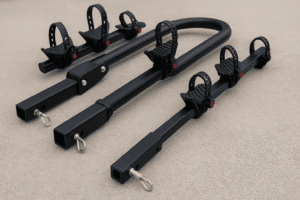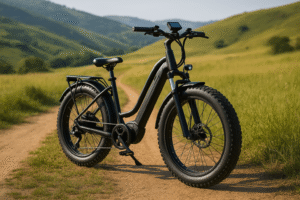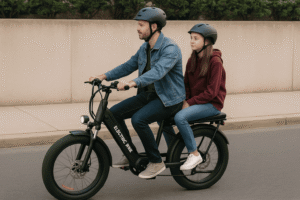Why do people pedal electric bikes when they have a motor? The answer is simple: pedaling makes the ride more efficient, extends battery life, and keeps riders active. While an e-bike provides motor assistance, pedaling is still an important part of the experience.
Whether it’s for better control, longer range, or a bit of exercise, pedaling helps riders get the most out of their e-bikes.
Key Takeaways:
- Pedaling extends battery life by reducing how much power the motor needs, especially on long or hilly rides.
- You can ride without pedaling on throttle-only e-bikes, but it’s less efficient and not always legal in some areas.
- Pedal-assist gives better control and makes the ride feel smoother and more natural, especially when climbing or carrying extra weight.
- E-bikes still offer exercise since you can adjust how much effort you put in, combining fitness with convenience.
How Electric Bikes Work
Electric bikes work by combining human pedaling with motor assistance. The motor kicks in when you pedal, giving you extra power without doing all the work for you.
Most e-bikes have a pedal-assist system (PAS), where sensors detect your pedaling effort and adjust motor output accordingly. This makes riding feel natural while reducing strain, especially on hills or long rides.
There are also throttle-controlled e-bikes, which allow riders to accelerate without pedaling. However, these are often limited by local laws and can drain the battery faster.
The amount of help you get depends on the assist levels available. Most e-bikes offer multiple modes, from light support to strong motor power. You can switch between them depending on your needs—using high assistance for hills and lower levels for flat roads to save battery.
Why Do People Pedal Electric Bikes?
People pedal electric bikes to make the most of their ride. Pedaling extends battery life, provides a workout, and ensures smoother control over speed.
Even though the motor helps, relying solely on it drains the battery quickly. Pedaling helps conserve power, allowing you to travel farther on a single charge.
Many riders also enjoy the health benefits of light exercise while riding, making e-bikes a great option for staying active without overexerting.
In some places, e-bike laws require pedaling to activate the motor. This means that even if the bike has a throttle, you may still need to pedal at least a little to get moving.
Can You Ride an E-Bike Without Pedaling?
Yes, but it depends on the type of e-bike. Throttle-controlled e-bikes can move without pedaling, while pedal-assist models require at least some effort from the rider.
Throttle-only e-bikes allow you to twist a handle or press a button to accelerate without pedaling. However, this drains the battery much faster and can make riding less stable. Many regions also have legal restrictions on throttle use, classifying these bikes as mopeds rather than bicycles.
Most e-bikes work best with a combination of pedaling and motor power. This balance provides a smooth, natural riding experience while maximizing battery life.
Why Can’t a Throttle Be Used All the Time?
Using a throttle continuously drains the battery quickly and can strain the motor, reducing its lifespan.
Throttle-only riding also takes away the benefits of pedaling, such as better speed control and longer range. That’s why many e-bike riders prefer pedal assist, which provides power when needed while keeping the ride efficient and enjoyable.
How Pedaling Improves E-Bike Performance in Different Conditions

Pedaling isn’t just about saving battery—it also enhances how an e-bike handles different terrains and situations:
- Climbing Hills – Pedaling helps the motor push uphill more smoothly and efficiently.
- Headwinds – Riding against strong wind is easier when combining pedal power with motor assistance.
- Heavy Loads – Cargo e-bikes and commuters benefit from pedaling when carrying extra weight.
- Uneven Terrain – Pedaling provides better control and stability on rough roads or trails.
- Long-Distance Rides – Conserving battery by pedaling extends the bike’s range significantly.
E-Bike Pedaling Tips for Maximum Efficiency
To get the most out of your e-bike, pedal smartly and use assist wisely:
- Choose the right assist level – Use low assistance on flat roads and higher levels for hills.
- Pedal smoothly – Keep a steady pace to work with the motor instead of against it.
- Shift gears properly – Lower gears make climbing hills easier, while higher gears help maintain speed on flat terrain.
- Monitor battery usage – Conserve power by pedaling more on easy sections of your ride.
- Use throttle sparingly – Relying too much on throttle mode can shorten battery life.
Conclusion
So, why do people pedal electric bikes? The answer is simple: it makes the ride better in every way. Pedaling extends battery life, improves control, and provides a bit of exercise without making the ride exhausting. It also helps riders comply with e-bike laws in many places, ensuring they can ride safely and legally.
An electric bike isn’t just about convenience—it’s about having the freedom to ride the way you want. Whether you use pedal assist for an easier ride or rely on your legs for a workout, e-bikes offer the best of both worlds. By pedaling, you get a smoother, more efficient, and more enjoyable experience every time you hit the road.
FAQs
Do all electric bikes require pedaling?
Not all e-bikes require pedaling. Some have a throttle that allows you to ride without pedaling, but many models require at least some pedaling, especially in regions with strict e-bike laws.
How much does pedaling help the battery last longer?
Pedaling can significantly extend an e-bike’s range. Using pedal assist instead of full throttle reduces battery drain and allows you to ride longer on a single charge.
Can you get a workout on an electric bike?
Yes! While e-bikes make riding easier, pedaling still engages your muscles and helps with cardiovascular fitness. You can adjust the level of assistance to get as much or as little exercise as you want.
What happens if my e-bike battery dies while riding?
If the battery runs out, you can still pedal the bike like a regular bicycle. However, e-bikes are heavier than traditional bikes, so riding without assistance might require more effort.
Are electric bikes allowed on cycling paths?
It depends on local laws. Many areas allow pedal-assist e-bikes on bike paths, but throttle-controlled e-bikes may have restrictions. Always check the regulations in your area before riding.
Does pedaling make an electric bike go faster?
Pedaling can help maintain a higher speed, but most e-bikes have a speed limit where the motor stops assisting. In many places, this limit is around 15.5 mph (25 km/h) for pedal-assist e-bikes and up to 28 mph (45 km/h) for some Class 3 e-bikes.
Michael Josh is a hands-on e-bike tester and reviewer at BoltBikers, known for putting every model through real-world rides before sharing his thoughts. With a sharp eye for performance, comfort, and build quality, he helps the team choose which bikes are worth featuring. Backed by years of experience in tech and gear reviews, Michael brings trusted, honest insights to help readers find the right e-bike for their needs.








